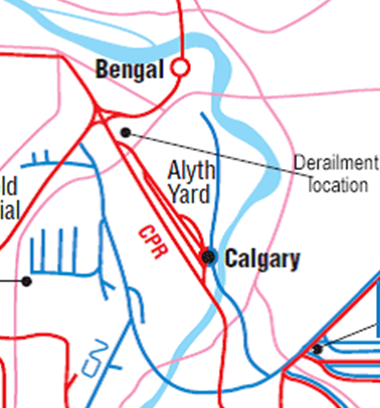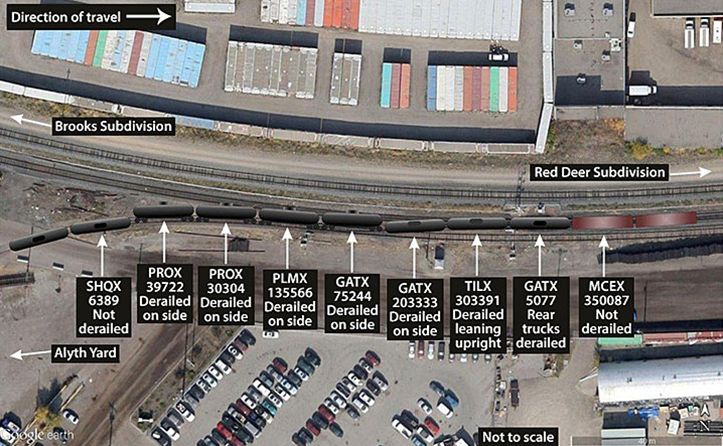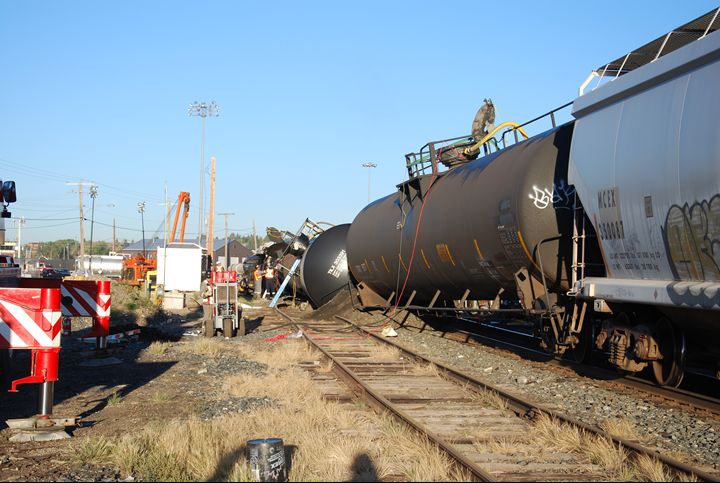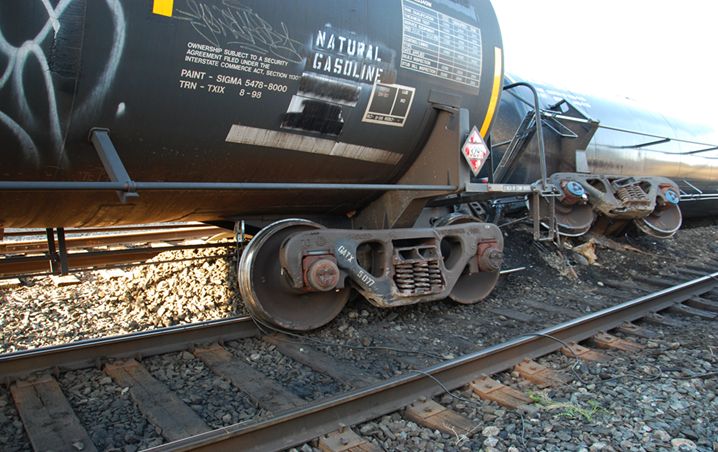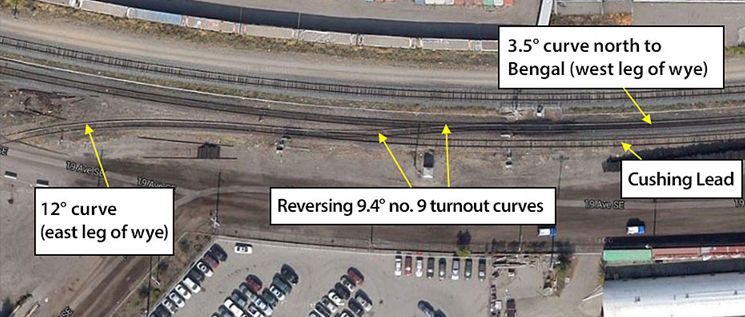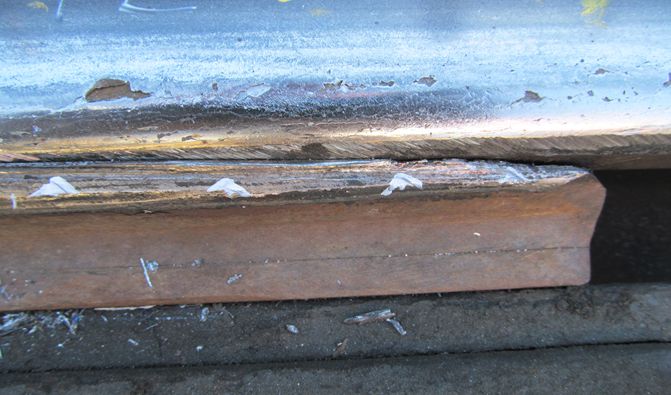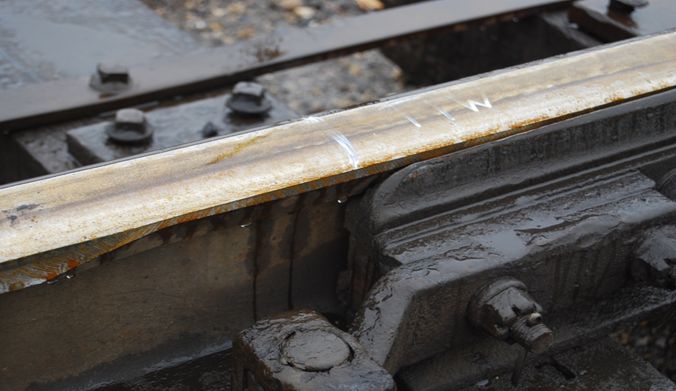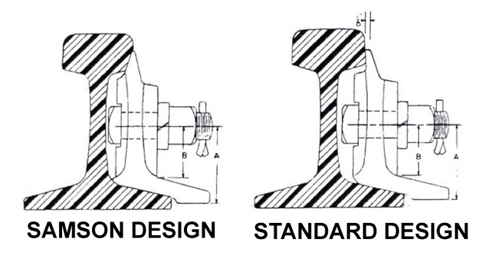Main-track derailment
Canadian Pacific Railway
Freight train 467-11
Mile 0.30, Red Deer Subdivision
Calgary, Alberta
The Transportation Safety Board of Canada (TSB) investigated this occurrence for the purpose of advancing transportation safety. It is not the function of the Board to assign fault or determine civil or criminal liability. This report is not created for use in the context of legal, disciplinary or other proceedings. See Ownership and use of content. Masculine pronouns and position titles may be used to signify all genders to comply with the Canadian Transportation Accident Investigation and Safety Board Act (S.C. 1989, c. 3).
Summary
On 11 September 2013, at about 1630 Mountain Daylight Time, Canadian Pacific Railway freight train 467-11 departing northward from Alyth Yard in Calgary, Alberta, en route to Red Deer, Alberta, derailed 7 tank cars loaded with liquid hydrocarbons at Mile 0.30 on the Red Deer Subdivision, in the Inglewood neighborhood of Calgary. About 600 feet of track was destroyed. There were no injuries and there was no product loss.
Factual information
The accident
On 11 September 2013, at about 1630,Footnote 1 Canadian Pacific Railway (CP) freight train 467-11 (the train) departed Alyth Yard in Calgary, Alberta, destined for Red Deer, Alberta. The distributed power trainFootnote 2 consisted of three 6-axle, 4400 hp General Electric (GE) locomotives, two of which were on the head end followed by 68 rail cars, and a mid-train locomotive followed by 123 rail cars. The train weighed 14 320 tons and was 11 274 feet long.
As the train was departing Alyth Yard northward on the Red Deer Subdivision (see Figure 1), a train-initiated emergency brake application occurred. After making the necessary emergency broadcast and notifying the rail traffic controller (RTC), the conductor performed an inspection and determined that 7 tank cars had derailed, the 164th to the 170th cars. The derailed tank cars, loaded with liquid hydrocarbons, were not leaking any product. However, a 1-inch natural gas line that was supplying gas to a switch heater was severed during the derailment. The natural gas was initially released to the atmosphere, but was quickly contained when the supply line was shut down by a technician from the gas company. There were no injuries.
Train marshalling
The 69 loaded cars were marshalled throughout the train at 14 locations in groups of cars ranging from 1 car to 10 cars. The 122 empty cars were marshalled throughout the train at 13 locations in groups of cars ranging from 1 car to 31 cars. The 7 loaded tank cars that derailed were immediately preceded by 31 empty cars.
CP uses an in-house marshalling program, Train Area Marshalling or TrAM, to regulate the distribution of tonnage and power on its trains so that in-train forces can be safely managed. The physical and operating characteristics of the railway's territories (subdivisions) were evaluated, and 5 different train marshalling areas were established with Area 1 being the least restricted and Area 5 being most restricted.Footnote 3 The Red Deer Subdivision is designated TrAM Area 1.
Weather
At the time of the occurrence, the weather was 24°C with clear skies.
Site examination
The derailment occurred in the neighbourhood of Inglewood in an urban/industrial area of Calgary (see Figure 2). The first derailed car (GATX 5077) was upright, and the trailing A end truck and wheels were derailed. The following tank car was derailed and leaning to the south side of the track. These cars were followed by 5 tank cars that had derailed on their sides (see Photo 1).
The derailed tank cars were loaded with liquid hydrocarbons, not otherwise specified (N.O.S). The product was placarded as UN 3295, which is commonly referred to as natural gasoline condensate or natural gasoline (see Photo 2). This product is most commonly used as a diluent for bitumenFootnote 4 to lower its viscosity so it can flow through pipelines.
The point of derailment was determined to be at Mile 0.3, where there is a crossover from the Alyth Yard track to the Red Deer Subdivision. Impact marks and flange markings were observed post-accident on the running surface of the right-hand switch point of the divergent route of the turnout (see Photo 3). Wheels had climbed up on top of the switch point and had travelled along the top of the rail before falling between the point and the stock rail.
Crew information
The train crew consisted of a locomotive engineer and a conductor. Both crew members were qualified for their respective positions, met rest and fitness standards and were familiar with the subdivision.
Recorded information
The locomotive event recorder data were examined. It was determined that
- the train was travelling at 11 mph when a train-initiated emergency brake application occurred at 1631:33;
- the throttle was in position 2;
- the locomotive independent and train brakes were released; and
- the train stopped about 15 seconds after the emergency application was initiated.
Subdivision information
The Red Deer Subdivision runs north from Alyth Yard in Calgary (Mile 0.0) to Red Deer (Mile 95.6). Train movements on this subdivision are controlled by Interlocking Rules between Mile 0.0 and Mile 1.2, by the Centralized Traffic Control System from Mile 1.2 to Mile 16.6, and by the Occupancy Control System from Mile 16.6 to Mile 95.6. Both train control systems are authorized by the Canadian Rail Operating Rules. Train operations are supervised by an RTC located in Calgary.
Approximately 10 trains per day operate over the crossover between Alyth Yard and the Red Deer Subdivision.
Track information
The route from Alyth Yard to the Red Deer Subdivision follows a tight 947-foot-long, 12° right-hand curve. This section of track also serves as the east leg of the wye at the north end of Alyth Yard.
After negotiating the 12° curve, trains enter a short tangent section (about 50 feet) leading to the crossover at Mile 0.3. This crossover consisted of two 115-pound no. 9 turnouts connected with reversing 9.4° curves. Exiting the crossover, trains enter a 3.5°, 6072-foot-long left-hand curve that is the west leg of the wye (see Figure 3). This track and the Cushing Lead run parallel to each other northward to Bengal where they join before crossing the Bow River.
The crossover turnouts were installed with head-hardened switch points measuring 16 feet 6 inches, rail bound manganese frogs and spike and screw fastenings. The right-hand switch point was a non-Samson, standard point and had been replaced earlier that week due to regular wear (see Photo 3). The left-hand switch point was a Samson point (see Photo 4). The Samson point was in good condition as was the stock rail and the other turnout components. Both Samson and non-Samson switch points can be safely used in the same turnout.
In 2012, the 12° curve was rebuilt with hardwood ties, 136-pound rail and elastic fasteners on rolled plates. The curve was also realigned to a uniform 12° curvature, and the south crossover switch was realigned in relation to the north crossover switch to improve the transition through the crossover switches. The curve realignment provided a short section (about 50 feet) of tangent track between the 12° curve and the south crossover switch to allow freight car trucks to realign themselves ahead of the crossover.
Track inspection
The most recent track geometry test on the east leg of wye, which included testing the track through the crossovers, had been conducted on 28 May 2013. During this test, no track geometry defects were identified in the vicinity of the crossover.
The most recent rail flaw test was conducted on 11 August 2013. No rail defects were detected in the vicinity of the east leg of the wye.
Samson switch points
Since 2007, Samson switch have been specified as a CP standard in new construction on certain sized turnouts. When switch points are replaced for maintenance reasons and Samson switch points are installed with appropriate stock rail, preference is given to installing the Samson switch point/stock rail assembly on the divergent route where there is an abrupt change in wheel set contact.
Figure 4 presents a schematic cross section of the Samson switch point and of the standard switch point. The Samson switch point design ensures that wheel flange impacts from rolling stock travelling through the switch point are reduced. Specifically, for Samson switch points, the lower corner of the head of the stock rail (on the gauge side) is machined at an angle. This machining on the stock rail is referred to as an undercut that houses the point under the stock rail. The undercut protects the switch point from direct impact from the oncoming wheel flanges. In addition, the angled fit resists “scissor action” between the switch point and the stock rail. Stock rails for Samson switch points are supplied from the manufacturer with the undercut.
Tank car information
The tank cars involved in the derailment were built to specification 112J340W (Class 112). These Class 112 tank cars were equipped with jacketed thermal protection, puncture-resistant tank heads, and double shelfFootnote 5 couplers. These cars are pressure tank cars that are designed for top loading and unloading without bottom connections.
Following the derailment, the first 2 derailed tank cars (i.e., TILX 303391 and GATX 5077) were moved from the accident site to a CP repair facility. A truck teardownFootnote 6 was performed for these tank cars. It was determined that
- there were no pre-existing equipment defects; and
- no condemnable wear conditions were identified on the trucks or wheels of either tank car.
The car maintenance records were examined for the 7 derailed tank cars. No abnormalities were noted. Table 1 provides additional information for the derailed tank cars.
| Consist number | Car number | Build date | Year of last tank test |
|---|---|---|---|
| 164 | GATX 5077 | August 1998 | 2008 |
| 165 | TILX 303391 | February 2008 | 2010 |
| 166 | GATX 203333 | November 2006 | 2010 |
| 167 | GATX 75244 | March 2000 | 2010 |
| 168 | PLMX 135566 | October 2003 | 2013 |
| 169 | PROX 30304 | December 1996 | 2006 |
| 170 | PROX 39722 | November 2012 | 2012 |
Incident response and evacuation
The Hazardous Materials Group of the Calgary Fire Department (CFD) responded to the derailment. The CFD set up its incident command post on scene. Due to the natural gas release from the severed line supplying the switch heater, the CFD prohibited access to the site. In addition, homes and buildings in the vicinity were evacuated. About 140 homes and 12 businesses were affected. Other responding organizations/agencies included CP, Transport Canada, Alberta Environment, Alberta Transportation of Dangerous Goods and the Calgary Police. Site access was restricted until plans were developed to transload and re-rail the derailed tank cars.
During the initial hours of the occurrence, 2 major roads (i.e., Ninth Avenue and Blackfoot Trail) were closed. The road closures resulted in detours for road traffic and transit routes. As the derailment had occurred during a peak traffic period, a significant traffic jam in the vicinity of the occurrence resulted for several hours.
For CP, when derailments involving dangerous goods occur in rural areas, CP personnel will normally assume the incident command role. In these situations, CP will generally have more resources, a higher level of technical knowledge and expertise as compared to local emergency responders. As this derailment occurred within city limits, the City of Calgary considered this event a matter of public safety. City emergency responders therefore assumed the lead role and were in charge of the scene. CP personnel were initially part of the unified command structure in a supporting role. As the response and subsequent cleanup progressed, the incident command post transitioned to a joint incident command structure involving both CFD and CP personnel.
Dangerous goods
The 4-digit product UN number (UN 3295) and hazard class listed on car placards (located at 4 locations on each tank car) cover several different hydrocarbon products with similar chemical composition. The UN number does not necessarily uniquely identify the product being transported. However, in this case, in addition to the placard, the common product name (i.e., natural gasoline) was stencilled on the tank cars. Because the cars being used to transport the product were pressure tank cars (DOT 112J) that exceeded the minimum requirements for containment and transportation of natural gasoline (Class 3, Packing Group II), the CFD requested the product Material Safety Data Sheet (MSDS)Footnote 7 and further clarification from the shipper that the cars were in fact loaded with the product listed on the compressed waybills.Footnote 8 The MSDS described the product as UN 1203, Gasoline, Class 3, PG II and the compressed waybill listed the product as NA 1993, Combustible Liquid, n.o.s. (Petroleum Distillate), Class 3, placarded combustible.
During the initial hours of the occurrence, additional information for the dangerous goods was available from other sources including:
- The train consist provided train information, including car numbers, the position of the car in the train, Association of American Railroads (AAR) car type, commodity, dangerous goods UN number, load/empty car status, shipper, consignee and standard transportation commodity codes. The train consist was made available from the conductor.
- The Emergency Response Guidebook (ERG)Footnote 9 provides guidance to first responders during the initial phase of a dangerous goods/hazardous materials transportation incident. In this occurrence, the ERG was in the possession of the train crew and the emergency responders.
Although it took some time to determine the exact contents of the tank cars, the CFD considered that it had sufficient information to respond to this accident. When it was considered safe to do so, the derailed tank cars that were on their sides were righted and the product was removed.
Analysis
Neither the condition of the rolling stock nor the manner in which the train was operated was considered contributory to this accident. The investigation will focus on the track layout and switch type and condition.
The accident
Given that only the trailing truck of the 164th car derailed, it is likely that the leading wheel of the 165th car was the first to derail, dragging the trailing truck of the 164th car off with it. The following 5 cars derailed as the train was coming to a stop. The double shelf couplers likely contributed to the derailment and rolling over of the tank cars as the couplers prevented the initial separation of the cars and transferred the rotational force from car to car as the derailment progressed.
As the train entered and transitioned through the crossover between the east and west legs of the wye, it encountered a recently installed, right-hand, standard, non-Samson switch point. For a standard switch point, lateral forces on the point rail can be substantial, even under normal train handling conditions. The point rail, a section of straight rail planed to a fine tip, represents a location where there is an abrupt change in wheel set contact. Specifically, when negotiating a non-Samson turnout, the wheel sets will encounter the point rail with a more aggressive angle of attack, resulting in higher flange forces at the wheel-rail interface, particularly if the point does not have a tight fit against the stock rail. The derailment occurred when wheels climbed up on top of the right switch point of the south crossover switch and travelled along the top of the point until falling between the point and stock rail near the heel block. Wheel flanges striking the non-Samson switch point resulted in overstress impacts on the tip of the point, creating a ramp for a wheel flange to climb up on top.
Departing from Alyth Yard for the Red Deer Subdivision, the train was travelling through a sharp, 12° right-hand curve, crossover turnouts with 9.4° reverse curves and a 3.5° left-hand curve. Parts of the train were located on these sections of track at the same time. Furthermore, just prior to the derailment, 31 empty cars had traversed the turnout (the 133rd car to 163rd car). Due to their relatively light weight and the slow speed of the movement, it is likely that the empty cars would be tracking away from the standard switch point (stringlining through the turnout curve) while loaded cars would be tracking more towards the standard switch point. Given the track layout, including a combination of curves and short tangent sections, the transition from empty to loaded cars entering the crossover likely resulted in the wheels of the loaded cars tracking more towards the standard switch point.
Train marshalling
The train was built with quantities of loaded and empty cars marshalled at various locations. There were 27 separate groups of cars among the 191 total over a distance of more than 2 miles of train; 14 groups of loaded cars and 13 groups of empty cars. Locomotives were distributed at 2 locations—front and middle—to help manage in-train forces. At the time of the derailment, the train was moving slowly and it was not under heavy pull or braking action. It was therefore unlikely that excessive longitudinal forces were generated. Despite the variation of load/empty car distribution throughout the train, there was no indication that train marshalling was a factor in the derailment.
Samson switch points
Samson switch points are usually installed on both rails or, if only one is to be used, it is preferably installed on the more heavily travelled route through the turnout, if available. Both Samson and non-Samson switch points can be safely used in the same turnout. When only one Samson point is installed, preference is given to installation on the divergent route. However, it is good maintenance practice to have them both Samson.
In this case, most traffic is northward using the diverging route of the turnout, which did not have a Samson point and stock rail. While the Samson switch point was protected from wheel flanges on through movements to the Cushing Lead through the turnout, the non-Samson switch point was exposed to many more wheel flanges (and potentially more overstress impacts) on movements taking the diverging route to the Red Deer Subdivision. Samson switch points lessen the angle of attack by wheel sets at the wheel-rail interface and reduce overstress impact from wheel flanges. If the right-hand or diverging route switch point had also been a Samson point, the risk of switch point damage and wheel-climb derailment would have been significantly reduced.
The derailment occurred despite strengthening the 12° curve at the east leg of the wye and improving track geometry through the wye and crossover curves to allow the trucks on the freight cars to re-align themselves prior to reaching the crossover.
Emergency response
The unified command structure worked well in securing the site and developing and executing the plan to safely remove the product from the derailed cars and removing the cars from the area without incident.
In an urban area, a large evacuation can be complex, disruptive and costly to implement. In this occurrence, a half-mile (800 m) radius evacuation was implemented. The size of the evacuation was determined based on the dangerous goods information obtained by the emergency responders. This information was provided by CP and was also obtained from the response guidelines contained in the Emergency Response Guidebook. Despite initial inconsistency in product identification, the Calgary Fire Department knew the general characteristics of the product and responded effectively to this accident.
Findings
Findings as to causes and contributing factors
- The derailment occurred when wheels climbed up on top of the right switch point of the south crossover switch and travelled along the top of the point until falling between the point and stock rail.
- Wheel flanges striking the non-Samson switch point resulted in overstress impacts on the tip of the point, creating a ramp for a wheel flange to climb up on top.
- Given the track layout, including a combination of curves and short tangent sections, the transition from empty to loaded cars entering the crossover likely resulted in the wheels of the loaded cars tracking more towards the standard switch point.
Findings as to risk
- If the right-hand or diverging route switch point had also been a Samson point, the risk of switch point damage and wheel-climb derailment would have been significantly reduced.
Other findings
- Despite the variation of load/empty car distribution throughout the train, there was no indication that train marshalling was a factor in the derailment.
- The derailment occurred despite strengthening the 12° curve at the east leg of the wye and improving track geometry through the wye and crossover curves to allow the trucks on the freight cars to re-align themselves prior to reaching the crossover.
- The unified command structure worked well in securing the site and developing and executing the plan to safely remove the product from the derailed cars and removing the cars from the area without incident.
Safety action
Safety action taken
Canadian Pacific Railway (CP) removed the crossover switches at Mile 0.30 to prevent any risk of a subsequent incident. The Cushing Lead was strengthened and upgraded to 136-pound rail and surfaced. At Mile 1.1, a new No. 15, 136-pound turnout was installed to replace an existing 115-pound turnout. In its present configuration, the east and west legs of the wye now function independently and are joined at the new turnout at Mile 1.1 at Bengal.
This report concludes the Transportation Safety Board's investigation into this occurrence. the Board authorized the release of this report on . It was officially released on 14 January 2015.
